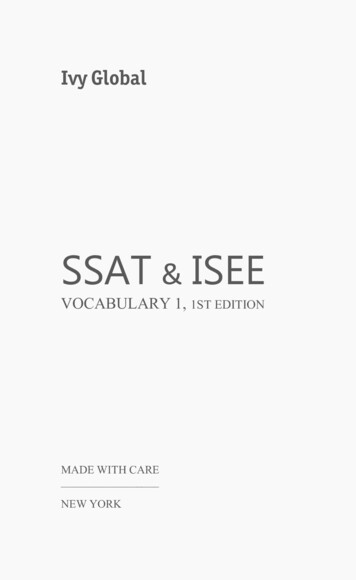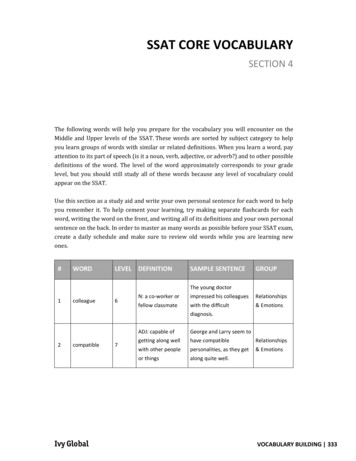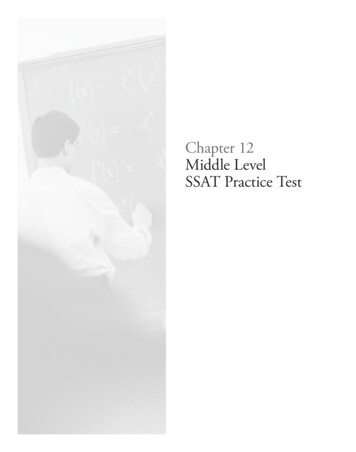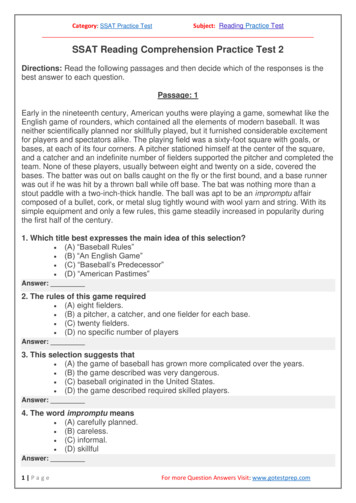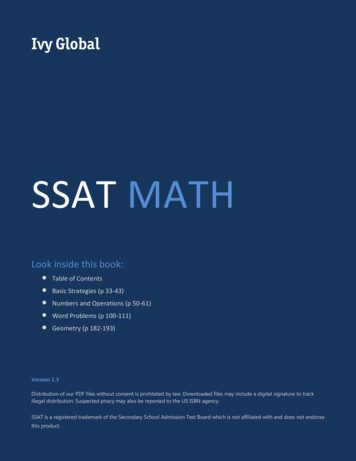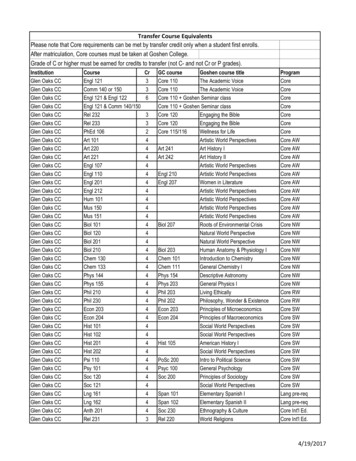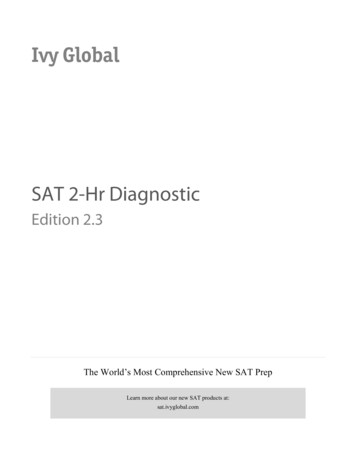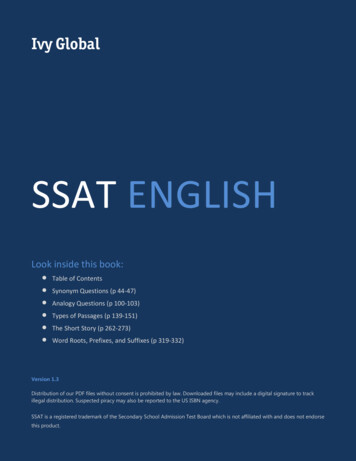
Transcription
Ivy GlobalSSAT ENGLISHLook inside this book: Table of Contents Synonym Questions (p 44-47) Analogy Questions (p 100-103) Types of Passages (p 139-151) The Short Story (p 262-273) Word Roots, Prefixes, and Suffixes (p 319-332)Version 1.3Distribution of our PDF files without consent is prohibited by law. Downloaded files may include a digital signature to trackillegal distribution. Suspected piracy may also be reported to the US ISBN agency.SSAT is a registered trademark of the Secondary School Admission Test Board which is not affiliated with and does not endorsethis product.
CONTENTSChapter 1: Introduction . 1How to Use this Book . 3About the SSAT . 5Chapter 2: Test-Taking Strategies . 11Approaching the SSAT . 13Chapter 3: The Verbal Section . 29Introduction . 31Part 1: Synonyms . 33Synonym Strategies . 34Synonym Practice Questions . 44Part 2: Analogies . 73Analogy Strategies . 74Types of Analogies . 78If You Get Stuck . 87Word Classifications . 89Analogy Practice Questions . 100Chapter 4: The Reading Section . 123Introduction . 125Critical Reading Strategies .127Types of Passages .139Types of Questions . 159Reading Practice Questions . 172
Chapter 5: The Writing Sample . 243Part 1: About the Writing Sample . 245Introduction . 246Writing Basics . 247Part 2: The Short Story . 261Introduction . 262Writing a Short Story . 263Sample Stories and Prompts . 279Part 3: The Essay – Upper Level Only . 285Introduction . 286Persuasive Essays . 289Informative Essays . 300Chapter 6: Vocabulary Building . 311Introduction . 312Word Roots, Prefixes, and Suffixes . 319Common Word Roots, Prefixes, and Suffixes . 326SSAT Core Vocabulary . 353Chapter 7: Answer Keys . 399The Verbal Section . 401The Reading Section . 407The Writing Sample . 409Vocabulary Building . 414
SYNONYM PRACTICE QUESTIONSSECTION 2In this section, you will find 246 practice questions to prepare you for the types of synonymquestions you might find on the SSAT. There are 6 sets of questions, grouped by difficulty.Pay attention to the difficulty of each set to determine which questions are appropriate forthe Middle and Upper Levels.WARM-UP QUESTIONSUse these questions to test your familiarity with basic synonym strategies for both theMiddle and Upper Levels.1. ERROR:3. CREATE:(A) edit(A) find(B) fear(B) glimpse(C) mistake(C) adore(D) frustration(D) break(E) pause(E) make2. EXIT:4. REPLACEMENT:(A) open(A) mission(B) leave(B) stand-in(C) wave(C) pretense(D) undo(D) move(E) experience(E) locationTHE VERBAL SECTION 44
5. BOLD:8. SCARE:(A) old(A) cry(B) nasty(B) frighten(C) daring(C) scold(D) weak(D) shove(E) submissive(E) lose6. TRY:9. BOTHER:(A) attempt(A) tickle(B) hold(B) snuggle(C) plow(C) snap at(D) desire(D) ignore(E) put(E) annoy7. EMBRACE:10. STUMBLE:(A) laugh(A) hum(B) spoil(B) chatter(C) hug(C) trip(D) scold(D) rage(E) lug(E) throwTHE VERBAL SECTION 45
BASIC QUESTIONSUse these questions to practice the most basic difficulty level you might see in both theMiddle and Upper Level synonym sections. The Middle Level exam will include more basicquestions than the Upper Level exam.1. DEMAND:5. MIRACLE:(A) employ(A) gift(B) punish(B) fortune(C) give to(C) life(D) ask for(D) wonder(E) yell(E) symbol2. SHRIEK:6. TECHNIQUE:(A) ghost(A) point(B) prince(B) engineer(C) screech(C) detail(D) whistle(D) direction(E) song(E) method3. CASUAL:7. INSPECT:(A) unnecessary(A) answer(B) traditional(B) plan(C) disrespectful(C) examine(D) resulting(D) ignore(E) informal(E) require4. HAZY:8. ATTRACT:(A) sad(A) fight(B) unclear(B) annoy(C) sloppy(C) refuse(D) laughable(D) interest(E) harmful(E) surpriseTHE VERBAL SECTION 46
9. REALITY:14. FERTILE:(A) vision(A) productive(B) theory(B) deserted(C) truth(C) warm(D) sorrow(D) sympathetic(E) persistence(E) girlish10. DECEIVE:15. REFRESH:(A) clarify(A) polish(B) unwrap(B) caress(C) predict(C) practice(D) control(D) renew(E) lie to(E) retreat11. REGRETFUL:16. COMBINE:(A) enraged(A) join(B) sorry(B) whisk(C) stubborn(C) list(D) gleeful(D) braid(E) homesick(E) visit12. DETACH:17. CONSTRUCT:(A) curse(A) carry(B) separate(B) withdraw(C) attack(C) explain(D) torture(D) destroy(E) knock down(E) build13. CRATER:18. VILE:(A) cavity(A) tasty(B) lake(B) disgusting(C) mountain(C) strong(D) sphere(D) syrupy(E) moon(E) unknownTHE VERBAL SECTION 47
ANALOGY PRACTICE QUESTIONSSECTION 5In this section, you will find 185 practice questions to prepare you for the types of analogyquestions you might find on the SSAT. There are 6 sets of questions, grouped by difficulty.Pay attention to the difficulty of each set to determine which questions are appropriate forthe Middle and Upper Levels.WARM-UP QUESTIONSUse these questions to test your familiarity with basic analogy strategies for both theMiddle and Upper Levels.1. Soda is to can as banana is to3. Desk is to office as(A) seed(A) window is to attic(B) eat(B) table is to kitchen(C) peel(C) lamp is to ceiling(D) fruit(D) study is to library(E) split(E) ottoman is to sofa2. President is to country as mayor isto4. Painter is to painting as architect isto(A) school(A) building(B) stadium(B) song(C) house(C) sculpture(D) city(D) wood(E) author(E) wallTHE VERBAL SECTION 100
5. Lamp is to lampshade as8. Happy is to sad as(A) bird is to fly(A) messy is to sloppy(B) dog is to leash(B) smiling is to laughing(C) window is to curtain(C) nice is to mean(D) fire is to chimney(D) angry is to tired(E) snow is to ground(E) confused is to puzzle6. Bluebird is to fly as9. Butterfly is to caterpillar as(A) human is to stand(A) puppy is to kitten(B) mute is to talk(B) frog is to tadpole(C) lion is to attack(C) crab is to lobster(D) otter is to swim(D) joey is to elephant(E) frog is to amphibian(E) cat is to sphinx7. Ski is to mountain as swim is to10. Hide-and-seek is to game as(A) valley(A) play is to win(B) rainforest(B) basketball is to baseball(C) park(C) coat is to shirt(D) lake(D) follow is to lead(E) sunshine(E) fairy tale is to storyTHE VERBAL SECTION 101
BASIC QUESTIONSUse these questions to practice the most basic difficulty level you might see in both theMiddle and Upper Level analogy sections. The Middle Level exam will include more basicquestions than the Upper Level exam.1. Trim is to hair as prune is to5. Laugh is to comedy as(A) plum(A) film is to watch(B) grass(B) scream is to horror(C) fruit(C) drama is to suspense(D) hedge(D) fantasy is to imagine(E) shear(E) argue is to agree2. Salmon is to fish as grizzly is to6. Palm is to hand as(A) burly(A) shoulder is to arm(B) polar(B) ankle is to leg(C) hunt(C) neck is to spine(D) bear(D) sole is to foot(E) prey(E) bone is to tendon3. Europe is to continent as Atlanticis to7. Hinge is to door as(A) knee is to leg(A) Pacific(B) spoke is to wheel(B) America(C) notebook is to spine(C) channel(D) lead is to pencil(D) glacier(E) motion is to stillness(E) ocean8. Musician is to band as4. Hunger is to food as(A) club is to member(A) sadness is to fighting(B) performance is to an actor(B) thirst is to beverage(C) playwright is to play(C) clown is to sick(D) opera is to aria(D) tired is to bedtime(E) singer is to chorus(E) dirty is to cleanTHE VERBAL SECTION 102
9. Foot is to sock as hand is to14. Look is to cook as(A) bracelet(A) cool is to boot(B) glove(B) soot is to foot(C) ring(C) aroma is to drama(D) palm(D) manage is to carnage(E) sole(E) rough is to plough10. Car is to garage as15. Kite is to wind as(A) bicycle is to vehicle(A) candle is to wax(B) boat is to dock(B) chair is to wood(C) train is to locomotive(C) lantern is to flame(D) shed is to tractor(D) helium is to balloon(E) pedestrian is to foot(E) surfboard is to wave11. Field is to wheat as16. Mitten is to glove as(A) plant is to carrot(A) spoon is to fork(B) garden is to cultivate(B) scarf is to hat(C) soil is to potato(C) snowball is to tennis ball(D) pasture is to cow(D) boot is to ankle(E) vine is to trellis(E) soup is to bread12. Chef is to apron as17. Lion is to zebra as(A) ballerina is to tiara(A) whale is to frog(B) painter is to smock(B) dog is to pet(C) lawyer is to suit(C) owl is to mouse(D) gardener is to glove(D) squirrel is to hawk(E) fireman is to protect(E) wolf is to predator13. Couch is to chair as18. Mechanic is to wrench as(A) expensive is to leather(A) spatula is to cook(B) soft is to flexible(B) nurse is to health(C) pool is to lake(C) spinster is to wheel(D) bus is to car(D) tailor is to needle(E) horse is to camel(E) carpenter is to woodTHE VERBAL SECTION 103
TYPES OF PASSAGESSECTION 3The SSAT Reading Section includes approximately seven or eight short passages that youwill need to read and analyze under a time limit. In this section, we’ll discuss the four maintypes of passages you will see on the exam: informative passages, persuasive passages,short stories, and poems. Continue reading for specific strategies to help you analyze eachtype of passage.INFORMATIVE PASSAGESInformative passages explain or describe a main topic. You might find an informativepassage in an encyclopedia, textbook, or even a newspaper story that informs readersabout a recent event. On the SSAT, you might see a wide range of topics, from science to artto history.MAJOR COMPONENTSA common structure for informative passages includes the following components: Introduction: The opening sentences of a passage normally introduce the readerto the main topic of the passage. However, sometimes the introduction for an SSATpassage will be very brief, and sometimes it might be missing altogether! In thatcase, it will be up to you to figure out how the ideas in the passage are connected. Body: In an informative passage, each paragraph will give information about aparticular idea related to the main topic. For example, in a passage about ice cream,one paragraph might be about how ice cream is made, and another might detail thehistory of ice cream. In the previous section, we looked at strategies for identifyingthe key ideas in each body paragraph. Conclusion: The final sentences of a passage might summarize the main idea of thepassage. However, in an SSAT passage, the conclusion might be very brief ormissing altogether.THE READING SECTION 139
To illustrate these components, let’s take another look at the platypus passage from the lastsection, which is an informative passage:Line 51015The Duckbilled platypus is a small animal, native to Australia, with manyunusual characteristics. It is a very odd-looking animal; in fact, whenEuropeans first heard about the platypus, many thought such an odd-lookinganimal must be a fraud. Its head and feet are like a duck’s, its body is like aweasel’s, and its tail is like a beaver's. Its webbed feet help it swim, its oddshaped tail helps it to store fat, and its duck-like beak helps it find food inrivers.A platypus is a mammal, but is remarkably unlike almost every othermammal. The platypus lays eggs; it doesn't give birth like other mammals.Also, although all mammals give their young milk, the platypus has an unusualway of doing this: it actually sweats milk all over its body. But despite thesedifferences, the platypus has fur, like other mammals.Finally, the platypus has some amazing abilities. The platypus can seeelectricity: it senses electricity coming from other animals in the water anduses this ability to catch food and avoid predators. The platypus also hasvenomous spurs on its feet that allow it to defend itself. An animal that getstoo close to the platypus’s feet will be stung with a poison.Does this passage have an introduction? We might call the first sentence of the passage its(very brief) introduction, because it states the main topic of the entire passage: “TheDuckbilled platypus is a small animal, native to Australia, with many unusualcharacteristics.”The body of this passage includes the rest of the first paragraph and the next twoparagraphs. As we have already seen, each of these paragraphs describes a specific topicrelated to the main idea: the way the platypus looks, the way it is unlike other mammals,and some of its special abilities.Does this passage have a conclusion? No—there is no sentence or paragraph at the end thatsummarizes the main idea of the passage again. This is an example of a passage that endsbefore its conclusion. It might be incomplete—the author might go on to talk about somemore unusual traits of the platypus!PARAGRAPH STRUCTUREMany informative passages also have special internal structures within their paragraphs.Just like the passage as a whole, each paragraph has a topic sentence that serves as itsintroduction. The topic sentence introduces readers to the main idea of the paragraph. Thenext few sentences can be thought of as the body of the paragraph; they presentTHE READING SECTION 140
supporting details related to the topic sentence. Finally, a paragraph might end with aconcluding sentence that summarizes the main topic of the paragraph. The concludingsentence can also provide a transition to the next paragraph.For example, let’s take a look at the second paragraph of the platypus passage again:10A platypus is a mammal, but is remarkably unlike almost every othermammal. The platypus lays eggs; it doesn't give birth like other mammals.Also, although all mammals give their young milk, the platypus has an unusualway of doing this: it actually sweats milk all over its body. But despite thesedifferences, the platypus has fur, like other mammals.The topic sentence of this paragraph is its first sentence: “The platypus is a mammal, but isremarkably unlike almost every other mammal.” This sentence tells us that the topic of theparagraph is how the platypus is different from other mammals.The body of this paragraph includes the second and third sentences, which providesupporting detail about how the platypus is different from other mammals. These detailsinclude its egg-laying and milk-sweating habits.The final sentence of this paragraph might be called its conclusion because it explains whythe platypus is still a mammal, despite these differences.STRATEGIESWhen you read an informative passage, ask yourself the same three questions we discussedin the Critical Reading section:1. What are the author’s topics, or the key details being discussed in this passage?2. What is the author saying about these topics, or what is the main point of thepassage?3. What is the author’s purpose in this passage?The third question should be easy to answer: the purpose of an informative passage is toinform, explain, or describe. To answer the first two questions, review the strategies fromthe Critical Reading section. Looking for the main structure of the passage and the internalstructure of each paragraph will help you locate this information.Be careful: even if the topic of the passage is familiar to you, don’t allow your reading to beswayed by your own opinion or prior knowledge! The SSAT will only test you about whatthe author is saying. Ignore any information you might already know about the topic andlook only at the information on the page in front of you.THE READING SECTION 141
Exercise #1: Read the sample informative passage below, and then answer the questionsthat follow. Ask a trusted reader to check your work.Line 510One of the Seven Wonders of the Ancient World, the Hanging Gardens ofBabylon is the only one of the Wonders that may have been a legend.The gardens were attributed to King Nebuchadnezzar II, who ruled theancient city-state of Babylon between 605 and 562 BC. He is said to haveconstructed the gardens to please his homesick wife, Amytis of Media, wholonged for the plants of her homeland. The gardens were so massive that theyrequired a minimum of 8,200 gallons of water per day to remain lush andgreen. To prevent flooding and erosion from the daily watering,Nebuchadnezzar is reported to have used massive slabs of stone beneath andaround the gardens.Unfortunately, several earthquakes after the Second Century BC are saidto have destroyed the gardens. While ancient Greek and Roman writersdocumented the Hanging Gardens of Babylon, there is no definitivearchaeological evidence confirming their existence.1. Identify each of the following structural components of the passage as a whole:Introduction:Body:Conclusion:2. For the second paragraph (lines 3-9), identify the following components:Topic sentence:Supporting details:3. What are the author’s topics, or the key details being discussed in this passage?4. What is the author saying about these topics, or what is the main point of thepassage?THE READING SECTION 142
5. What is the author’s purpose in this passage?THE READING SECTION 143
PERSUASIVE PASSAGESIn a persuasive passage, the author tries to convince the reader of a specific position orargument. A persuasive passage might come from a political speech, an opinion essay, or anewspaper op-ed or letter to the editor.MAJOR COMPONENTSA persuasive passage differs from an informative passage because the author is presentingan opinion about a situation, rather than simply explaining or describing a topic. Thisopinion is called the author’s thesis, and an author normally uses specific supportingpoints or evidence to prove his or her opinion. Authors can use objective evidence, orfacts and statistics from outside sources. Authors can also use subjective evidence, orexamples from their own experiences. While a persuasive passage written with objectiveevidence will sound more detached and analytical, a persuasive essay written withsubjective evidence will sound more personal.Persuasive passages follow the same basic structure as informative passages, with a fewdifferences: Introduction: The opening sentences of a passage normally introduce the readerto the author’s main argument and thesis. Just like informative passages, however,the introduction for a persuasive passage on the SSAT might be very brief ormissing altogether. In that case, it will be up to you to find the author’s mainargument and thesis by reading the rest of the passage. Body: In a persuasive passage, each paragraph will provide a specific reason orexample that proves why the author’s thesis is true. These paragraphs contain theauthor’s evidence, either from outside sources (objective) or personal experience(subjective). Conclusion: The final sentences of a passage might summarize the main argumentof the passage. However, in an SSAT passage, the conclusion might be very brief ormissing altogether.To illustrate these components, let’s take a look at this example persuasive passage:THE READING SECTION 144
Line 51015Cell phones have become a staple of modern life. While they have manybenefits, such as improved communication, they can also be dangerous andcounterproductive.For one, cell phone use while driving is becoming increasinglycontroversial. Being distracted while operating a motor vehicle has resulted inan alarming increase in the number of car accidents. Because of this, manyjurisdictions prohibit the use of mobile phones while driving. Egypt, Israel,Japan, Portugal, and Singapore banned both handheld and hands-free use of amobile phone; others—including the UK, France, and many U.S. states—banned handheld phone use only, allowing hands-free use.In addition, cell phone use is being closely watched in schools. Becauseso many students have been using them to cheat on tests and bully others, cellphone use is usually restricted in schools. The benefits of cell phone use inschools have yet to be found because students’ use of cell phones has, for themost part, threatened the school’s security, distracted other students, andencouraged gossip and other social activities that harm learning.Besides being monitored in cars and schools, many cell phones arebanned in school locker room facilities, public restrooms, and swimming poolsdue to the built-in cameras that most phones now feature.Does this passage have an introduction? Yes, the first paragraph of the passage states boththe main topic of the passage (cell phone usage) as well as the author’s position about thistopic. The author’s thesis is stated in the second sentence: “While they have many benefits,such as improved communication, they can also be dangerous and counterproductive.”Based on this thesis statement, we expect that the rest of the passage will prove why andhow cell phones can be dangerous and counterproductive.The body of this passage includes the second, third, and fourth paragraphs. Each of theseparagraphs explains a specific situation where cell phones may be dangerous: Paragraph 2: Cell phones can be dangerous to use while driving. Paragraph 3: Cell phones can be dangerous to use in schools. Paragraph 4: Cell phones can be dangerous to use in locker rooms, restrooms, andswimming pools.In each paragraph, the author provides specific details about why cell phones can bedangerous in each of these situations. All of these details work together as the author’sevidence to support her thesis.Does this passage have a conclusion? No—there is no sentence or paragraph at the end thatsummarizes the author’s thesis and argument again. This is another example of a passageTHE READING SECTION 145
that ends before its conclusion. If the author were to continue the passage, what do youthink she would discuss next?STRATEGIESWhen you read a persuasive passage, start by asking yourself the same three questions wediscussed in the Critical Reading section:1. What are the author’s topics, or the key details being discussed in this passage?2. What is the author saying about these topics, or what is the main point of thepassage?3. What is the author’s purpose in this passage?The third question should be easy to answer: the purpose of a persuasive passage is topersuade or convince you of the author’s opinion. To answer the first two questions, reviewthe strategies from the Critical Reading section. In addition, help yourself by looking for themain components of the passage: the author’s thesis and supporting evidence.If you’re having difficulty understanding the passage, try to imagine who is speaking andwhom he or she might be speaking to. Is this the type of passage that would be delivered asa speech or a letter to a group of people, or as a speech or a letter to one specific person? Ifso, who do you think those people are? What type of situation might have led the author topropose this argument
Ivy Global SSAT ENGLISH Look inside this book: Table of Contents Synonym Questions (p 44-47) Analogy Questions (p 100-103) Types of Passages (p 139-151) The Short Story (p 262-273) Word Roots, Prefixes, and Suffixes (p 319-332) Version 1.3 Distribution of our PDF files without consent is prohibited by law.
